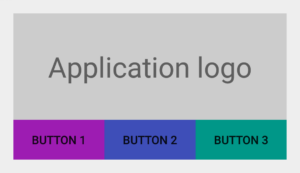巧用Drawable 实现Android UI 元素间距效果
源文地址: 巧用Drawable 实现Android UI 元素间距效果
在大部分的移动UI或者Web UI都是基于网格概念而设计的。这种网格一般都是有一些对其的方块组成,然后它们组合成为一个块。使用网格这种设计原则能够有助于对齐UI元素,提升UI的一致性。同一时候还能让用户更加easy的获取UI上面包括的内容。简而言之。网格是一个相当的强大的设计工具。
开发人员在使用网格设计原则的时候须要在UI 元素之间加入一些额外的间距。比方padding、margin或者spacing(依据你的设计方案来选择使用哪种间距) 。这些间距有利于在不同的块之间设置清晰的分隔带同一时候不会总体UI的可读性。这些间距对我们Android 开发人员来说也不陌生,我们在设计Android 界面时,也会使用View 的padding 和 margin 来达到类似的效果。在Android 开发中。为了将UI 和业务逻辑分隔,我们会使用 XML来定义UI。
这样的做法对于比較固定的UI非常有效果。但当这些UI元素须要依据业务逻辑来确定隐藏或者显示的状态时,这样的做法就有点困难了。这篇文章就依据这样的情况提出了一些Android开发技巧来应对动态的网格UI。
没有间距的UI
首先让我们来看一个简单的样例。我们创建一个简单的 LinearLayout 。
然后我们在TextView (显示“Application logo”)下方再内置一个 LinearLayout ,我们在当中水平依次放置3个Button。最后得到的效果图例如以下图所看到的:
<LinearLayout xmlns:android="http://schemas.android.com/apk/res/android"
android:layout_width="match_parent"
android:layout_height="wrap_content"
android:orientation="vertical"
android:padding="@dimen/spacing_medium"> <TextView
android:layout_width="match_parent"
android:layout_height="128dp"
android:background="@color/light_gray"
android:gravity="center"
android:text="@string/application_logo"
android:textAppearance="@android:style/TextAppearance.Material.Display1" /> <LinearLayout
android:id="@+id/buttons_container"
android:layout_width="match_parent"
android:layout_height="wrap_content"
android:orientation="horizontal"> <Button
android:id="@+id/btn_first"
android:layout_width="0dp"
android:layout_height="wrap_content"
android:layout_weight="1"
android:background="@drawable/purple"
android:text="@string/button_1" /> <Button
android:id="@+id/btn_second"
android:layout_width="0dp"
android:layout_height="wrap_content"
android:layout_weight="1"
android:background="@drawable/indigo"
android:text="@string/button_2" /> <Button
android:id="@+id/btn_third"
android:layout_width="0dp"
android:layout_height="wrap_content"
android:layout_weight="1"
android:background="@drawable/teal"
android:text="@string/button_3" /> </LinearLayout> </LinearLayout>

加入间距后的UI
上图的所展示的UI就是基于网格设计的。当时UI里面的元素之间都没有间距。为了让用户更好地区分这些UI元素。我们给id 为 @id/buttons_container 的 LinearLayout 加入属性 android:layout_marginTop="@dimen/spacing_medium" ;给id 为 @id/btn_first 和@id/btn_second 的两个 Button 分别加入属性 android:layout_marginRight="@dimen/spacing_medium" 。这时的UI效果例如以下图所看到的:

加入了间距之后,总体的UI效果好多了,可读性更强了。可当我们动态的隐藏某些 View 的时候就会出现一些问题了。我们如果第三个Button 会依据用户的设备是否安装了 Google Play Services 来决定它的展示。
如果这个设备没有 Google Play Services,那我们就把这个 Button to View.GONE 的 visibility 属性设为 View.GONE。 所得效果例如以下图:

出来的效果与我们预料中的一样,第三个 Button 没有再显示了。可是第二个 Button 的右边没有与上面的TextView 右边对齐。出现这样的问题的解决办法是:拥有 margin 属性的view 会觉得margin相应方向存在邻接 view。比如,每一个拥有right/top margin view会觉得它的 right/top 方向有一个邻接 view,因此,这个相应 margin 也就会生效,就算这个邻接view已经隐藏了。
设置间距的折衷方案——Java 和 GridLayout
一个比較直接的解决方式就是在Java 代码里面手动改变对应的margin 值,但说实话这不是一个好的方案。还有一个方案就是使用可以自己主动处理元素之间的间距的布局。GridLayout 就符合这种要求。可是这个布局让人蛋疼的是元素之间的间距不能自己定义。仅仅能使用默认的间距。
设置间距的最佳方案——LinearLayout 的divider
实际上 LinearLayout 已经有一个处理这样的元素之间的间距的属性了。
这个属性却没怎么被大家发现,一直非常低调,但它的效果相当奇妙。所以我们说的第三个方案就是使用一个固定高宽的 Drawable 作为 LinearLayout 的 元素分隔线(divider):
<?xml version="1.0" encoding="utf-8"? >
<shape xmlns:android="http://schemas.android.com/apk/res/android"
android:shape="rectangle"> <size
android:width="@dimen/spacing_medium"
android:height="@dimen/spacing_medium" /> <solid android:color="@android:color/transparent" /> </shape>
如今你就能够把这个新创建的 Drawable 设为LinearLayout 的 divider,这样这个Drawable 就能让元素之间产生间距了:
<LinearLayout xmlns:android="http://schemas.android.com/apk/res/android"
android:layout_width="match_parent"
android:layout_height="wrap_content"
android:divider="@drawable/spacer_medium"
android:orientation="vertical"
android:padding="@dimen/spacing_medium"
android:showDividers="middle"> <!-- TextView --> <LinearLayout
android:id="@+id/buttons_container"
android:layout_width="match_parent"
android:layout_height="wrap_content"
android:divider="@drawable/spacer_medium"
android:orientation="horizontal"
android:showDividers="middle"> <!-- Buttons --> </LinearLayout> </LinearLayout>

总结
Android 框架里面有很多的特性能够用来实现一些不常见的方案。并且最后效果出其不意。
定义 Drawable 就是当中一种途径。
假设你能吃透Android 里面的 Drawable 。那么你的代码也可能大大地精简。
注意:文章LinearLayout的divider 属性设置是Android
API 11之后加进去的,这意味着Android API 11之前的设备要使用这个divider须要LinearLayoutCompat。
本文翻译自:Grid
Spacing on Android 原文作者:Cyril
Mottier
巧用Drawable 实现Android UI 元素间距效果的更多相关文章
- 怎样进行Android UI元素设计
Android UI元素里面包含了许多的内容,比如:该平台由操作系统.中间件.用户界面和应用软件组成,一个应用程序要想受用户喜爱,那么UI可不能差. Android为相似的编程名词引入了一些新的术语, ...
- Android UI设计--半透明效果对话框及activity(可做遮罩层)
下面是style的一些属性及其解释 <style name="dialog_translucent" parent="@android:style/Theme.Di ...
- Android UI设计
Android UI设计--PopupWindow显示位置设置 摘要: 当点击某个按钮并弹出PopupWindow时,PopupWindow左下角默认与按钮对齐,但是如果PopupWindow是下图的 ...
- appium— Android定位webView里面的UI元素
Android SDK中的UIAutomator中本身是不支持网页中的UI元素定位,下面介绍几种常用的定位app内部的网页的UI元素的方法. 一.使用chrome浏览器调试移动端网页 这是使用最多的一 ...
- 详解 “Android UI”设计官方教程
我们曾经给大家一个<MeeGo移动终端设备开发UI设计基础教程>,同时很多朋友都在寻找Android UI开发的教程,我们从Android的官方开发者博客找了一份幻灯片,介绍了一些Andr ...
- Android UI设计规则
Android UI技巧 1.1 不该做什么 l 不要照搬你在其他平台的UI设计,应该让用户使用感觉是在真正使用一个Android软件,在你的LOGO显示和平台总体观感之间做好平衡 l 不要过度使 ...
- 各种Android UI开源框架 开源库
各种Android UI开源框架 开源库 转 https://blog.csdn.net/zhangdi_gdk2016/article/details/84643668 自己总结的Android开源 ...
- 【Android UI】Android开发之View的几种布局方式及实践
引言 通过前面两篇: Android 开发之旅:又见Hello World! Android 开发之旅:深入分析布局文件&又是“Hello World!” 我们对Android应用程序运行原理 ...
- Android UI性能优化实战, 识别View中的性能问题
出自:[张鸿洋的博客]来源:http://blog.csdn.net/lmj623565791/article/details/45556391 1.概述 2015年初google发布了Android ...
随机推荐
- postman做压力测试
压力测试 当你需要验证你的接口的抗压能力的时候,可以点击Runner,进行压力测试 注意:压力测试只能以文件夹的方式执行多个接口,不能单独执行,如果想要测试某一个接口,就创一个文件夹,这个文件夹里只有 ...
- sql is null
select * from a or state is null)
- cenos6.5作为网关
入口服务器(网关服务器)关闭selinuxsetenforce 0vim /etc/selinux/config将SELINUX=enforcing改为SELINUX=disabled 修改防火墙ip ...
- 条款20:宁以pass-by-reference-to-const替换pass-by-value(Prefer pass-by-reference-to-const to pass-by-value)
NOTE: 1.尽量以pass-by-reference-to-const 替换pass-by-value.前者通常比较高效,并可避免切割问题(slicing problem). 2.以上规则并不适用 ...
- LeetCode(16)3Sum Closest
题目 Given an array S of n integers, find three integers in S such that the sum is closest to a given ...
- linux中的vi命令
linux的重要的几个命令如下: ①,光标的操作 1,gg,G,nG,:n gg移到文档的开头一行,G移动到最后一行,nG移动到第n行,到指定的行. 2,H,M,L 光标分别移动到这个界面的最上边,中 ...
- 大数据学习——linux常用命令(三)
三 文件操作 1创建文件 touch somefile.txt 创建一个空文件somefile.txt > 重定向操作符 echo "woshiwoa"> some.t ...
- Laya 项目解耦
Manager解耦业务逻辑 Data解耦数据逻辑 View-UI解耦页面逻辑 ModuleController解耦通信逻辑
- 准确率(Precision),召回率(Recall)以及综合评价指标(F1-Measure)
准确率和召回率是数据挖掘中预测,互联网中得搜索引擎等经常涉及的两个概念和指标. 准确率:又称“精度”,“正确率” 召回率:又称“查全率” 以检索为例,可以把搜索情况用下图表示: 相关 不相关 检索 ...
- java邮件工具类【最终版】
http://www.xdemo.org/java-mail/ 对比链接中,添加了抄送和暗抄送功能(已解决,如图代码:抄送不能多个用户,会报错,未解之谜) sendHtmlmail方法可以发送附件以及 ...
